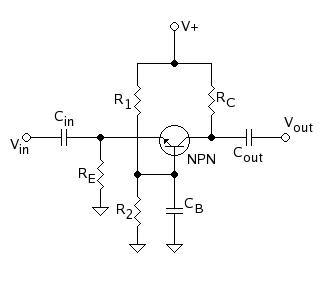Common base
- This article is about a concept in electronic circuits. For the philosophical concept, please see Common base (Unification Thought).

In electronics, common base or grounded-base refers to a type of bipolar transistor circuit configuration in which a transistor is connected such that its base terminal is wired to the ground or "common" rail of the circuit (or can be considered so for AC signals). In this configuration, the input signal is applied to the emitter, the output being at the collector.
This arrangement is not used as much as other configurations in low frequency circuits but is often employed for amplifiers that require an unusually low input impedance, for example to act as a preamplifier for moving-coil microphones. It is popular in high frequency amplifiers, for example for VHF and UHF, because its input capacitance is not increased by the Miller effect, which causes high frequency rolloff in the common emitter configuration. It also exhibits high input to output isolation, so is often seen in multi-stage amplifiers where such isolation is important.
Another significant application of this configuration is as current buffer, as the relation between the input current, IE and the output current, IC, is approximately 1.
Characteristics
(The parallel lines indicate components in parallel.)
Inherent voltage gain:
Current gain:
The variables not listed in the schematic are:
- gm is the transconductance in siemens, calculated by , where:
- is the collector bias current
- is the thermal voltage, calculated from Boltzmann's constant, the charge on an electron, and the transistor temperature in kelvins. At room temperature this is about 25 mV (Google calculator).
- is the current gain at low frequencies (commonly called hFE). This is a parameter specific to each transistor, and can be found on a datasheet.
See also
External links
- Basic BJT Amplifier Configurations
- NPN Common Base Amplifier — HyperPhysics
- The Common Base Amplifier, Physics Lecture Notes, D.M. Gingrich, University of Alberta Department of Physics











